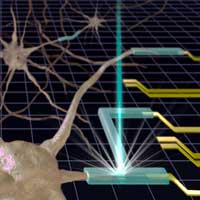| Sep 22, 2020 |
|
(Nanowerk News) Researchers at the National Institute of Standards and Technology (NIST) have developed a new method of 3D-printing gels and other soft materials. Published in a new paper (ACS Nano, “Electron and X-Ray Focused Beam Induced Crosslinking in Liquids: Toward Rapid Continuous 3D Nanoprinting and Interfacing using Soft Materials”), it has the potential to create complex structures with nanometer-scale precision.
|
|
Because many gels are compatible with living cells, the new method could jump-start the production of soft tiny medical devices such as drug delivery systems or flexible electrodes that can be inserted into the human body.
|
 |
| Illustration of a prospective biocompatible interface shows that hydrogels (green tubing), which can be generated by an electron or X-ray beam 3D-printing process, act as artificial synapses or junctions, connecting neurons (brown) to electrodes (yellow). (Image: A. Strelcov/NIST)
|
|
A standard 3D printer makes solid structures by creating sheets of material — typically plastic or rubber — and building them up layer by layer, like a lasagna, until the entire object is created.
|
|
Using a 3D printer to fabricate an object made of gel is a “bit more of a delicate cooking process,” said NIST researcher Andrei Kolmakov. In the standard method, the 3D printer chamber is filled with a soup of long-chain polymers — long groups of molecules bonded together — dissolved in water. Then “spices” are added — special molecules that are sensitive to light.
|
|
When light from the 3D printer activates those special molecules, they stitch together the chains of polymers so that they form a fluffy weblike structure. This scaffolding, still surrounded by liquid water, is the gel.
|
|
Typically, modern 3D gel printers have used ultraviolet or visible laser light to initiate formation of the gel scaffolding. However, Kolmakov and his colleagues have focused their attention on a different 3D-printing technique to fabricate gels, using beams of electrons or X-rays. Because these types of radiation have a higher energy, or shorter wavelength, than ultraviolet and visible light, these beams can be more tightly focused and therefore produce gels with finer structural detail.
|
|
Such detail is exactly what is needed for tissue engineering and many other medical and biological applications. Electrons and X-rays offer a second advantage: They do not require a special set of molecules to initiate the formation of gels.
|
|
But at present, the sources of this tightly focused, short-wavelength radiation — scanning electron microscopes and X-ray microscopes — can only operate in a vacuum. That’s a problem because in a vacuum the liquid in each chamber evaporates instead of forming a gel.
|
|
Kolmakov and his colleagues at NIST and at the Elettra Sincrotrone Trieste, in Italy, solved the issue and demonstrated 3D gel printing in liquids by placing an ultrathin barrier — a thin sheet of silicon nitride — between the vacuum and the liquid chamber. The thin sheet protects the liquid from evaporating (as it would ordinarily do in vacuum) but allows X-rays and electrons to penetrate into the liquid.
|
|
The method enabled the team to use the 3D-printing approach to create gels with structures as small as 100 nanometers (nm) — about 1,000 times thinner than a human hair. By refining their method, the researchers expect to imprint structures on the gels as small as 50 nm, the size of a small virus.
|
|
Some future structures made with this approach could include flexible injectable electrodes to monitor brain activity, biosensors for virus detection, soft micro-robots, and structures that can emulate and interact with living cells and provide a medium for their growth.
|
|
“We’re bringing new tools — electron beams and X-rays operating in liquids — into 3D printing of soft materials,” said Kolmakov.
|


